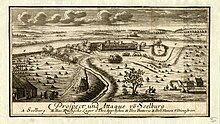Selburg Castle
| Selburg Castle | ||
|---|---|---|
| Creation time : | 1373 | |
| Conservation status: | ruin | |
| Place: | Stukmaņi | |
| Geographical location | 56 ° 35 '15 " N , 25 ° 38' 25" E | |
|
|
||
The castle Selburg ( Latvian Sēlpils pils , Latin Castrum Selonum ) is a ruin on the opposite Stukmaņi ( Stockmannshof ; City Pļaviņas lying island) Dvina .
Castle description
The castle is in old Selonia . Archaeological excavations have shown that the Selburg hill was as early as the end of the 9th century BC. Was settled. Finds from the hill are considered the oldest human evidence in what is now Latvia. A more intense life on the castle hill took place in the 10th – 12th centuries. Century, when the entire hill was inhabited by the Selons.
The castle of the Selonen was besieged in 1208 by the Crusader troops of the Brothers of the Sword and finally captured. The residents surrendered and were baptized. The undestroyed castle became the seat of the first bishop Bernhard zur Lippe. According to Heinrich's Livonian Chronicle , the stone castle was built in 1373.
There are 12 bailiffs from 1442 to 1559 and 2 Droste from 1451 to 1518. In 1627 the castle was burned under Conszeuski and in 1704, during the Great Northern War, it was blown up by troops under Adam Ludwig Lewenhaupt .
architecture
The castle built by the order was essentially an elongated building, the central part of which was completely in line with the older fortifications. As an order castle, the building combined the tasks of a fortress and a monastery and had a chapel, a captain's room for the brothers of the order, a remter or dining room, dormitories for the brothers and utility rooms. In addition to the few main walls, the entrance that has survived to this day is the one that led through a long arched and curved corridor in order to be able to better resist the invading enemy.
Individual evidence
- ↑ a b Armin Tuulse: The castles in Estonia and Latvia (= negotiations of the Estonian learned society . Volume 33 ). Õpetatud Eesti Seltsi Toimetused, S. 80-81 .
- ^ Karl Woldemar von Löwis of Menar: Burgenlexikon für Alt-Livland . Walters and Rapa, Riga 1922, p. 113 ( digitized version ).
- ^ W. Neumann: Die Ordensburgen in the so-called Polish Livonia, Mitteilungen Rig., 1890, 14th vol., Pp. 299–322


